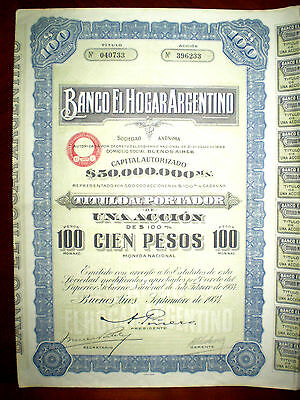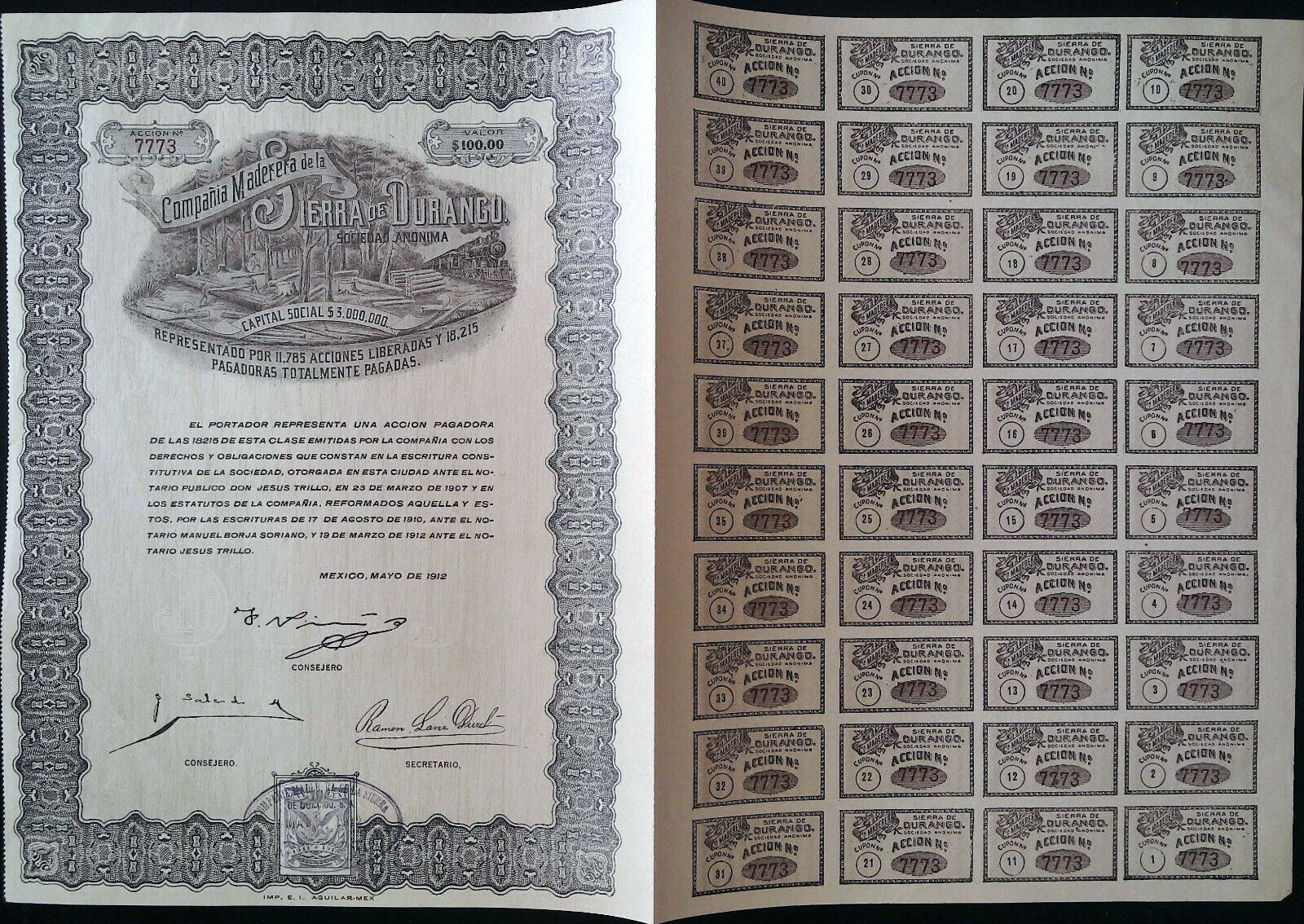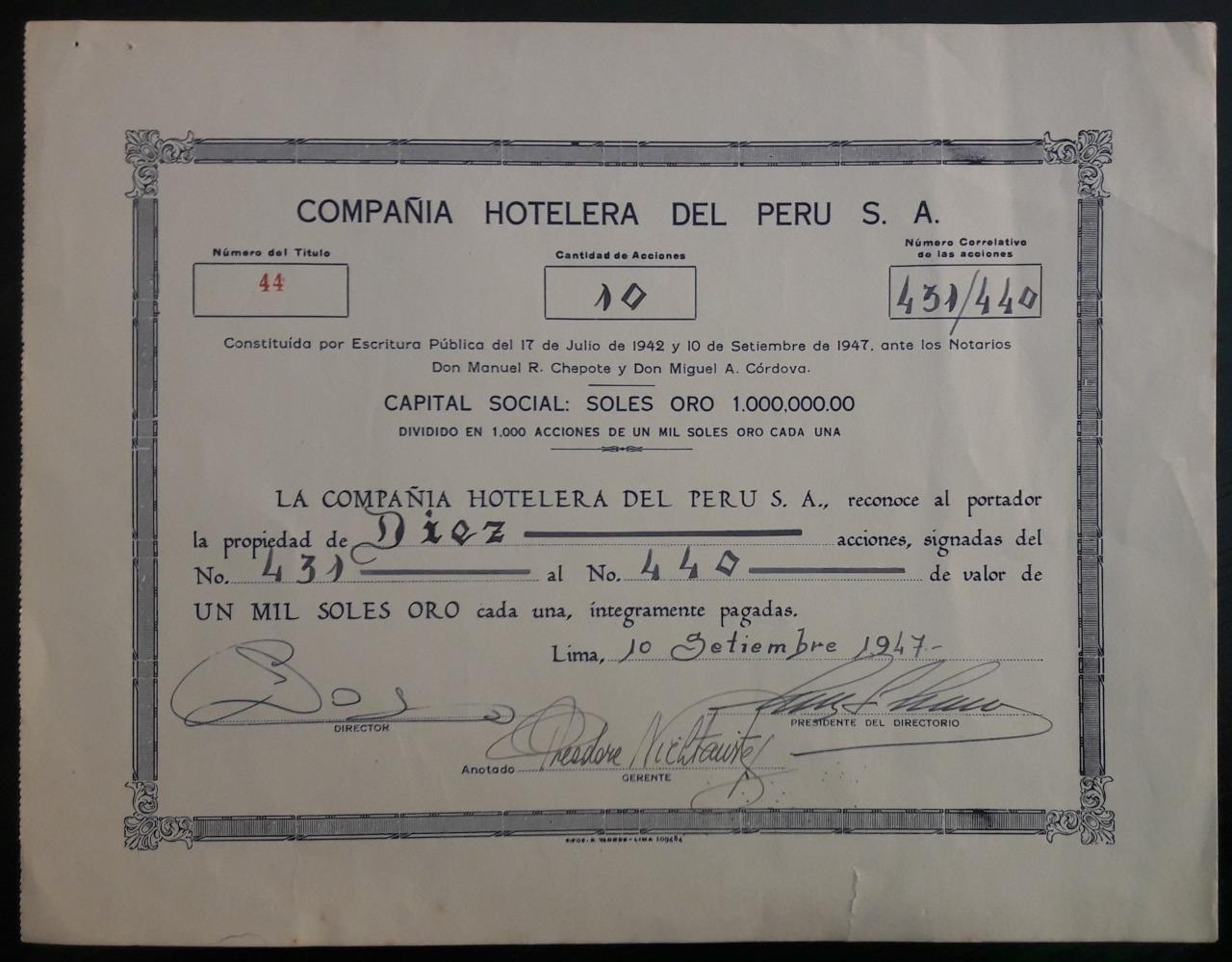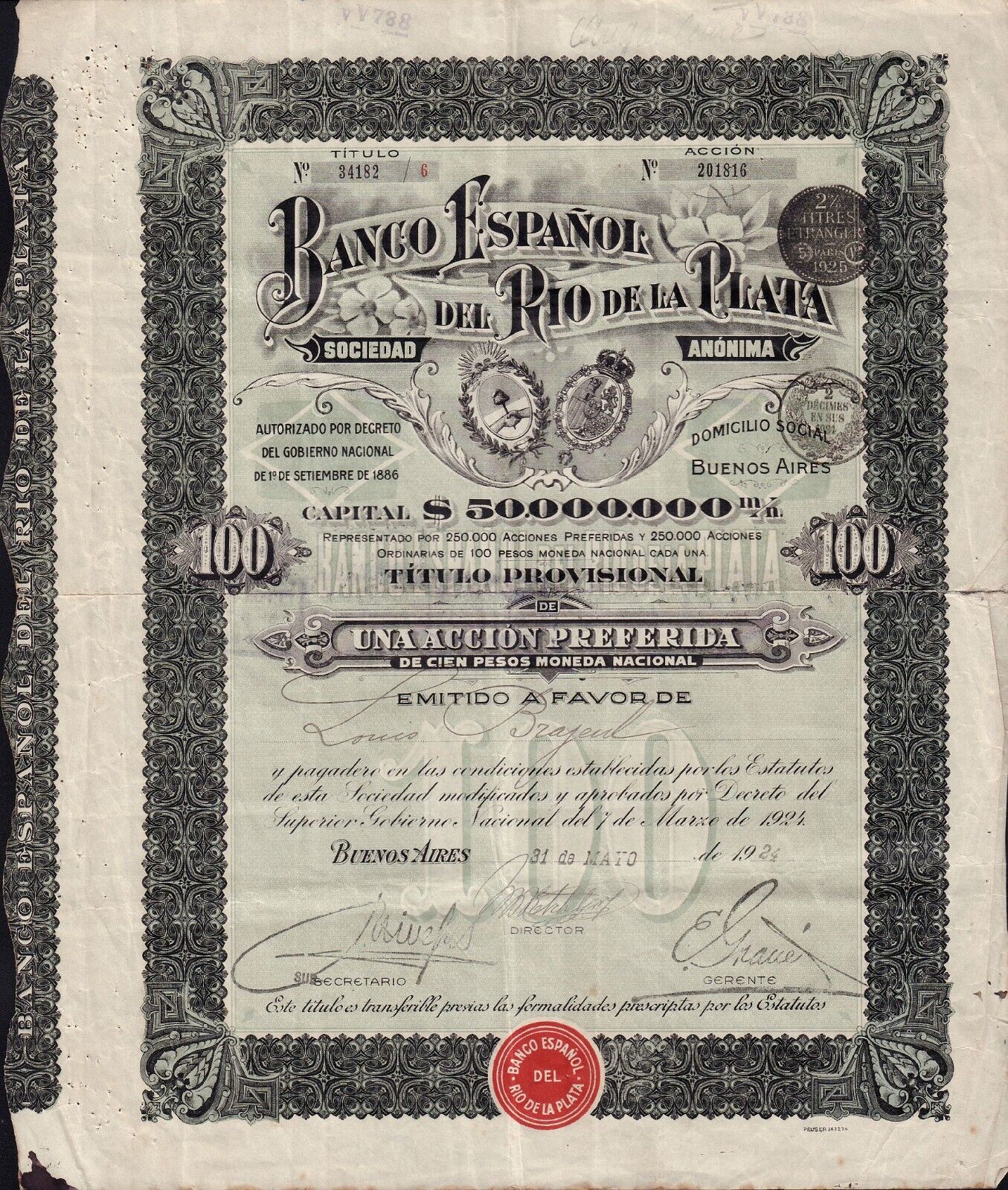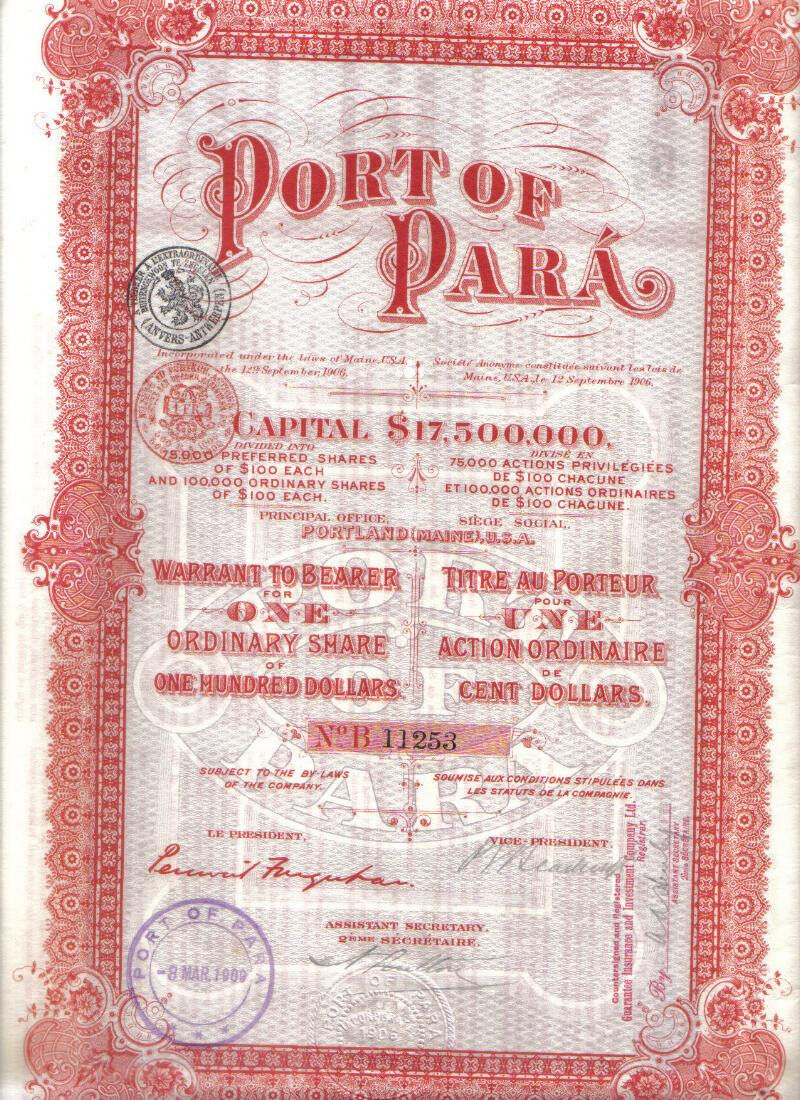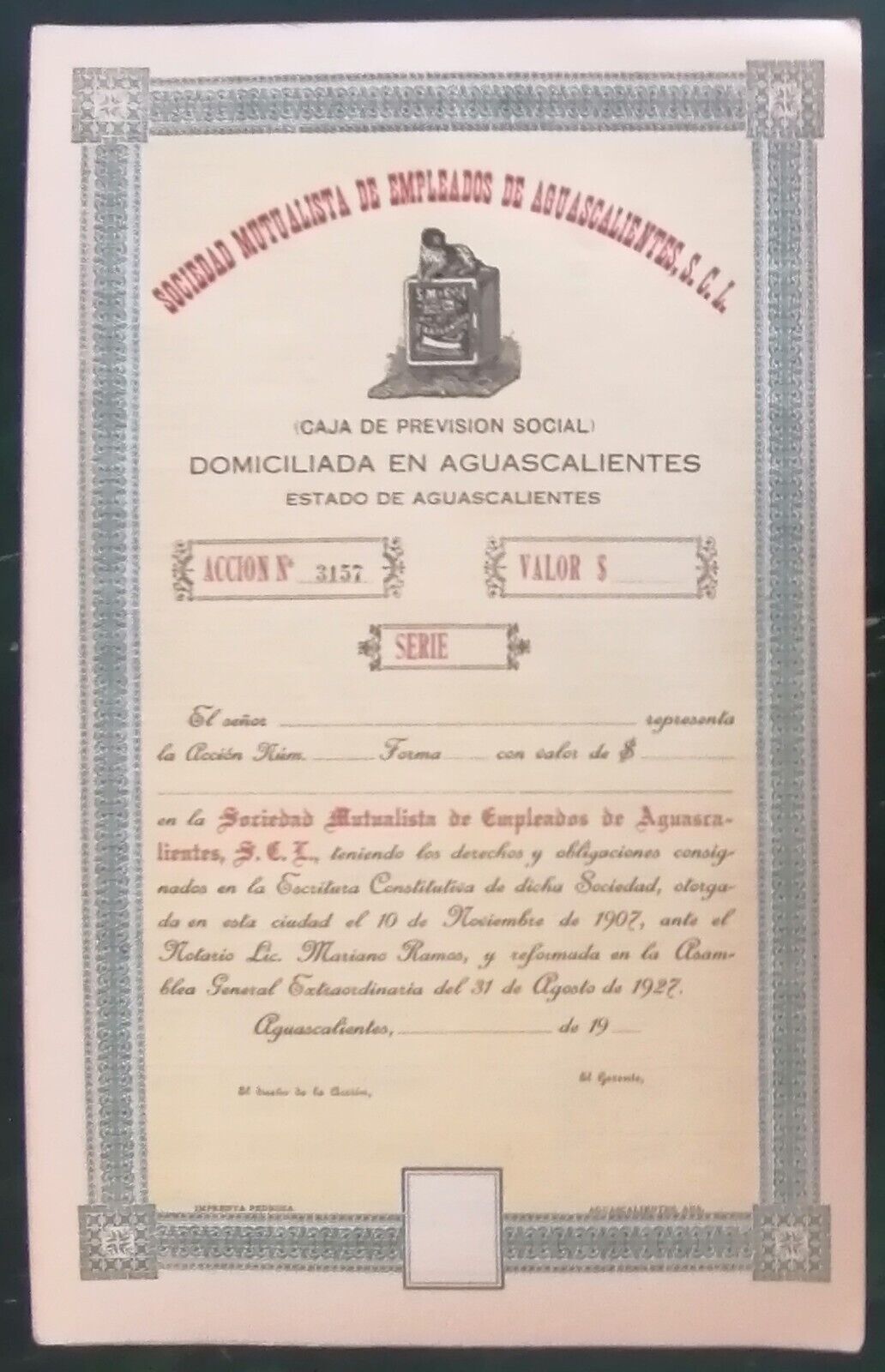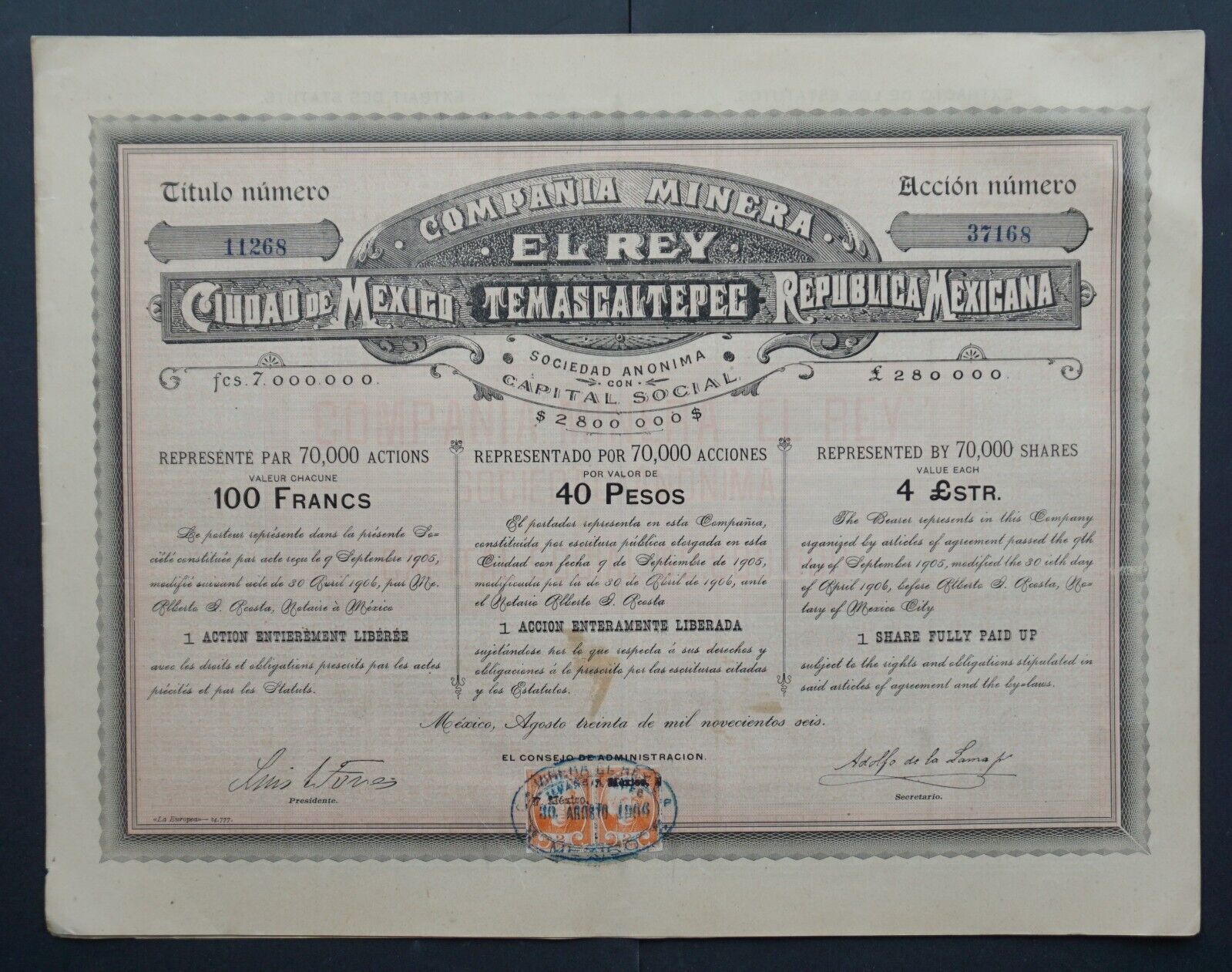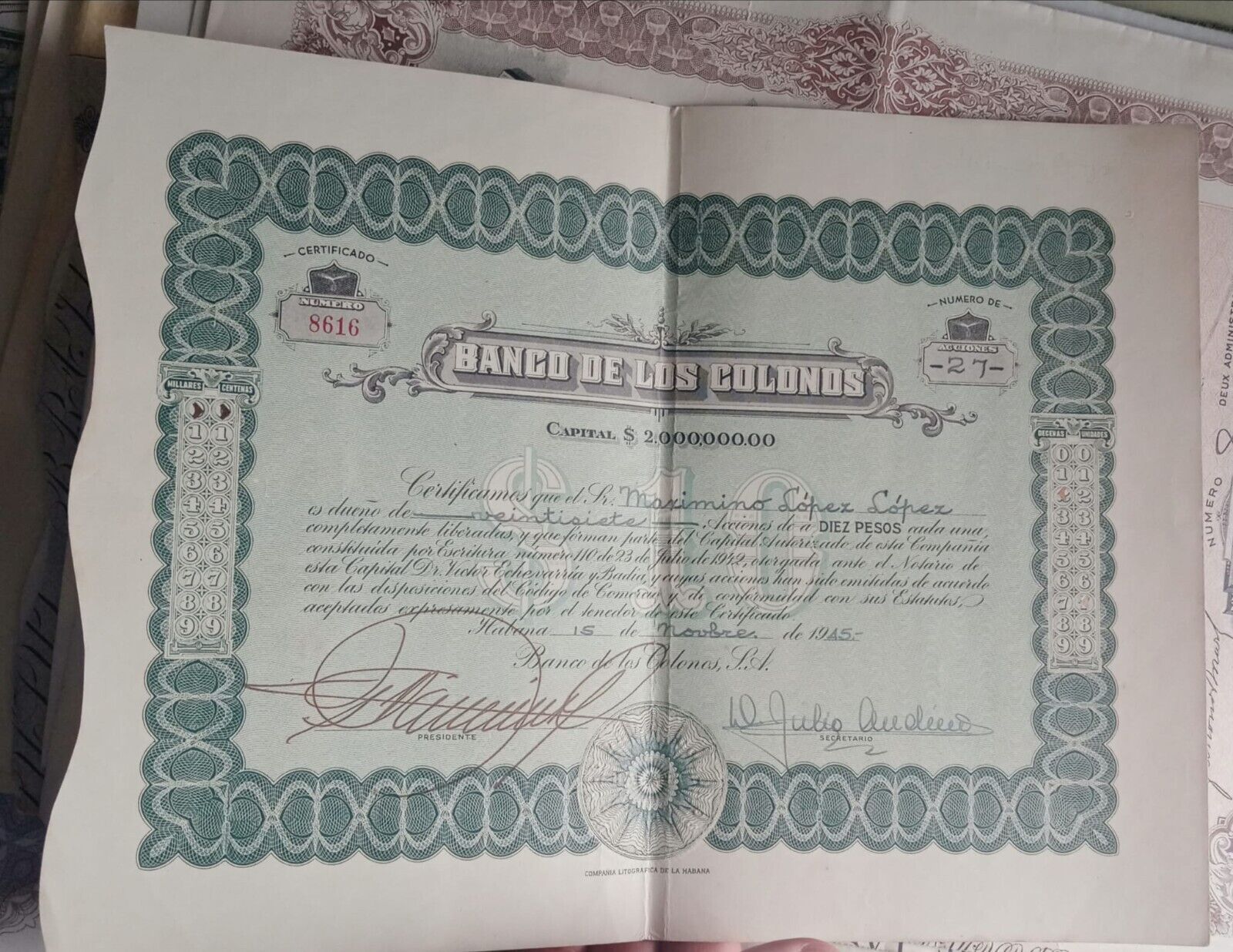-40%
Banco El Hogar Argentino,one share certificate 100 Pesos 1934
$ 9.5
- Description
- Size Guide
Description
One share certificate of : Banco El Hogar Argentino,one share certificate 100 Pesos 1934"BuenosAires (Argentina).Condition (opinion): Fine (F).See scan. Printer:G.Kraft Lda. Size:33 cm /22,5 cm (size without the coupons).Uncancelled .Two hand signatures.Dry seal.Contains coupons Nr.12 to Nr.40.See below some related information from the web.
-------------------------------------------------------------------------
Postage, including packing material, handling fees : Europe: USD 4.10 / USA $ 4.90. Rest of the World: USD 5.70
FREE of postage for any other additional banknote ,
stocks & bonds or other items
.
Only one shipping charge per shipment (the highest one) no matter how many items you buy (combined shipping).
-----------------------------------------------------------------------------
Guaranteed genuine -
One
month
return
policy
(retail sales).
When
there is
more than
one
banknote
for sale
the serial number
may
differ
from that shown
in
the
picture.
Full refund policy ,including shipping cost,guaranteed in case of lost or theft after the completion of the complaint with Spanish Correos for the registered letters (purchases above $ 40.00).
Customers are invited to combine purchases to save postage.
As we have (or could have) more than one identical item ,the serial number may differ from those shown in the picture which is for reference only.
For purchases above .00 we send the orders registered with tracking number without extra charge, for purchases below .00 we ship as regular letters at the buyer's risk.
For purchases below $ 40,00 who want to register your letter with tracking number, please add an extra for : Europe .00 , U.S. .00 ,Rest of the word .00
For some destinations and purchases below .00 customers may be requested for a small extra shipping payment in order to register the shipment with tracking number.
------------------------------------------------------------------------------
Banknote Grading
UNC
AU
EF
VF
F
VG
G
Fair
Poor
Uncirculated
About Uncirculated
Extremely Fine
Very Fine
Fine
Very Good
Good
Fair
Poor
Edges
no counting marks
light counting folds OR...
light counting folds
corners are not fully rounded
much handling on edges
rounded edges
Folds
no folds
...OR one light fold through center
max. three light folds or one strong crease
several horizontal and vertical folds
many folds and creases
Paper
color
paper is clean with bright colors
paper may have minimal dirt or some color smudging, but still crisp
paper is not excessively dirty, but may have some softness
paper may be dirty, discolored or stained
very dirty, discolored and with some writing
very dirty, discolorated, with writing and some obscured portions
very dirty, discolored, with writing and obscured portions
Tears
no tears
no tears into the border
minor tears in the border, but out of design
tears into the design
Holes
no holes
no center hole, but staple hole usual
center hole and staple hole
Integrity
no pieces missing
no large pieces missing
piece missing
piece missing or tape holding pieces together
Online translated -orientative only-see is Spanish below.--
History
The "Banco El Hogar Argentino" was founded in 1899 as a cooperative of small capital with the primary objective of providing land and housing for the working class, mainly coming from European immigration.
In 1926, the bank purchased a lot on Calle Bartolome Mitre, in full financial city neighborhood of San Nicolas.
To design your own new building, chose the project proposed by the architect Alejandro Virasoro, who was starting in his controversial architectural innovation.
Virasoro had acquired the designs and concepts of the new architecture that came with modernity, through the power is still charged with a sense of ornamentation, called years later Art Deco, which flourished in the interwar period in Europe and
U.S..
The new building built by the company of the same Virasoro, brought controversy in a society and a community of architects in which the taste for classical architecture and French influences were too firmly entrenched.
While finishing the Bank The Home Argentino, Virasoro edited in the Journal of the Society of Architects a controversial article calling for the renewal and modernization, which caused a broad repudiation and even a response from Alejandro Christophersen.
Vincent recalls Cacuri, construction of the Virasoro bank costs "(...) a serious failure of his health because of the misunderstanding.", Leaving the work for a time paralyzed by refusal of some shareholders of the entity itself.
Revuerda Cacuri felt voices "- I do not test these daubs on Florida!
The bank can not take the severity of a cemetery! ", 2 although the architect overcame adversity and was able to open his first work of carrying on this new and innovative style, then costruyendo other Art Deco architectural landmarks.
Years passed, and in 1963 the Home Argentino was absorbed by the Banco de Santander.
Thus, the Spanish bank had its first subsidiary in Latinoamérica.3 refunctionalized The building was by the architectural firm Antonini, Schon-Zemborain in 1992.4 Two years later, became the seat of the AFJP Origen, part of Grupo Santander.
In 2008, the company was taken over by ING.
But only a year later, in Argentina was made the re-nationalization of the pension system, and Origen disappeared.
Since then, the building functioned as an annex of the headquarters of Banco Santander Rio, formed in 2007 when Santander took over the River Bank.
Today is unoccupied and for rent.
The Bank building was controversial Argentine Hogar in 1926 and for the simple fact still present a new style emerging in Argentina, which also in the years to have its brief heyday, the Art Deco.
The main protagonist of this work is the central hall, which originally focused all the services to the public, and was thought to be also a place of exhibition of objects, etc..
Thus, the facade is designed as a large window, which occupies several levels with the appearance of a huge monumental frame, making it from the sidewalk you could see inside the bank.
Although the front of the building appears as a large square block, the building has a small tower that is not visible from the street level.
However, the bank hall occupies all floors, which are developed in the form of galleries overlooking the central space, so that you can see from the ground floor of this small roof tower.
This can be seen that the pyramidal roof of it is covered in glass, providing natural light to the bank day.
Moreover, the Bank was originally the home Argentino divided into two parts.
The first, covering the facade and the lobby-is made for this great space that has a unique level of three stories high, and above it three floors arranged as galleries.
The rear has seven floors, and these also include the vertical space in the front hall was starring with pyramidal tower.
---------------------------------------------------------
Historia
El Banco El Hogar Argentino fue fundado en 1899 como una cooperativa de reducido capital con el objetivo primordial de brindar terrenos y viviendas a la clase obrera, principalmente venida de la inmigración europea.
En 1926, la entidad financiera adquirió un terreno en la calle Bartolomé Mitre, en plena city financiera del barrio porteño de San Nicolás. Para diseñar su nuevo edificio propio, eligió el proyecto propuesto por el arquitecto Alejandro Virasoro, que estaba iniciándose en su controvertida innovación arquitectónica.
Virasoro había adquirido los diseños y conceptos de la nueva arquitectura que llegaba con la modernidad, a través de la corriente aún cargada con sentido de la ornamentación, llamada años más tarde Art Decó, y que tuvo su auge en el período de entreguerras en Europa y los Estados Unidos.
El nuevo edificio construido por la empresa del mismo Virasoro, trajo polémicas en una sociedad y una comunidad de arquitectos en las cuales el gusto por la arquitectura de influencias clásica y francesa estaban muy firmemente aferrados. Al tiempo que se terminaba el Banco El Hogar Argentino, Virasoro editaba en la revista de la Sociedad Central de Arquitectos un polémico artículo llamando a la renovación y la modernización,1 que le causó amplio repudio e incluso una respuesta de Alejandro Christophersen.
Según recuerda Vicente Cacuri, la construcción del banco le cuesta a Virasoro “(...) una grave quiebra de su salud a causa de la incomprensión.”, quedando la obra paralizada durante un tiempo por negativa de algunos accionistas de la entidad misma. Cacuri revuerda voces que opinaron “-¡Que no haga ensayos de esos mamarrachos en la calle Florida! ¡El banco no puede tener la severidad de un panteón!”,2 aunque el arquitecto superó la adversidad y pudo inaugurar su primera obra de porte en este nuevo e innovador estilo, costruyendo luego otros hitos arquitectónicos Art decó.
Pasaron los años, y en 1963 el Hogar Argentino fue absorbido por el Banco de Santander. Así, la entidad española tuvo su primera filial en Latinoamérica.3 El edificio fue refuncionalizado por el estudio de arquitectura Antonini-Schon-Zemborain, en 1992.4 Dos años después, se transformó en sede de la AFJP Orígenes, perteneciente al Grupo Santander. En 2008, la compañía pasó a manos de ING. Pero solo un año después, en Argentina se realizó la re-estatización del sistema de jubilaciones y pensiones, y Orígenes desapareció.
Desde ese momento, el edificio funcionó como anexo de la casa central del Banco Santander Río, formado en 2007 cuando el Grupo Santander absorbió al Banco Río. En la actualidad, está sin ocupar y en alquiler.
El edificio del Banco El Hogar Argentino resultó controvertido en 1926 ya por el simple hecho de presentar un nuevo estilo aún naciente en la Argentina, que igualmente en los siguientes años tendría su breve apogeo: el Art Decó.
El gran protagonista de esta obra es el hall central, que concentraba originalmente la totalidad de los servicios de atención al público, y estaba pensado para ser además lugar de exposición de objetos, etc. De tal forma, la fachada está pensada como una gran vidriera, que ocupa varios niveles con el aspecto de un inmenso marco monumental, haciendo que desde la vereda se pudiera observar el interior del banco.
Aunque el frente del edificio aparece como un gran bloque cuadrado, el edificio posee una pequeña torre que no es visible desde el nivel de la vereda. Sin embargo, el hall del banco ocupa todos los pisos, que se desarrollan en forma de galerías que miran al espacio central, de tal forma que es posible ver desde el piso de la planta baja el techo de esta pequeña torre. Así puede apreciarse que el techo piramidal de la misma está revestido en vidrio, brindando iluminación natural diurna al banco.
Por otra parte, el Banco El Hogar Argentino estaba originalmente dividido en dos partes. La primera -que abarca la fachada y el hall- está compuesta por este gran espacio que posee un nivel único de tres pisos de altura, y sobre él tres pisos más dispuestos como galerías. La parte trasera tiene siete pisos, y estos también abarcan el espacio vertical que en la parte delantera estaba protagonizado por el hall con torre piramidal.
Barrio Inglés
Es una manera comun de denominar a varias zonas de la ciudad autonoma de buenos aires, que por el accionar de grupos de trabajadores britanicos, usualmente ferroviarios, han tendido sub-barrios caracterizados por tener un alto indice de edificios, casas e instalaciones de estilo anglosajon, diferenciandose notablemente de el resto de la ciudad.
El "barrio ingles" mas conocido es uno instalado en el barrio de Caballito, pero no es el unico:
El barrio fue un emprendimiento llevado a cabo por el Banco El Hogar Argentino, una entidad financiera enfocada en facilitar el acceso a la vivienda. Fue construido alrededor del año 1923 y está delimitado por las calles: Valle (hacia el norte), Del Barco Centenera (este), Emilio Mitre (oeste) y Avenida Pedro Goyena (sur). En sentido norte-sur lo cruzan las calles Cachimayo y Nicolás Videla, y en sentido este-oeste lo atraviesa el Avenida Juan Bautista Alberdi.
Las casas, de estilos variados, fueron proyectadas por el ingeniero Bilbao La Vieja. Las construyeron "Parodi y Figuini", según recuerdan las inscripciones en sus fachadas. Todas poseen un pequeño patio delantero, y con el paso de las décadas, el aumento del valor del suelo y la capacidad de ascenso social, pasaron a ser viviendas de gran categoría que valen mucho en la actualidad.
Ante el avance de los desarrollos inmobiliarios en los alrededores, surgió la preocupación por resguardar a este conjunto homogéneo de un posible boom de la construcción que llevaría a su desaparición.
Deshacer cambios
Your browser does not support JavaScript. To view this page, enable JavaScript if it is disabled or upgrade your browser.
